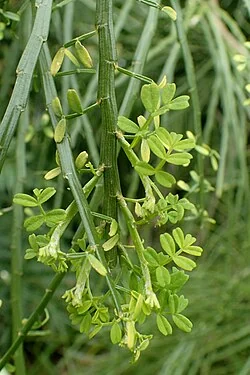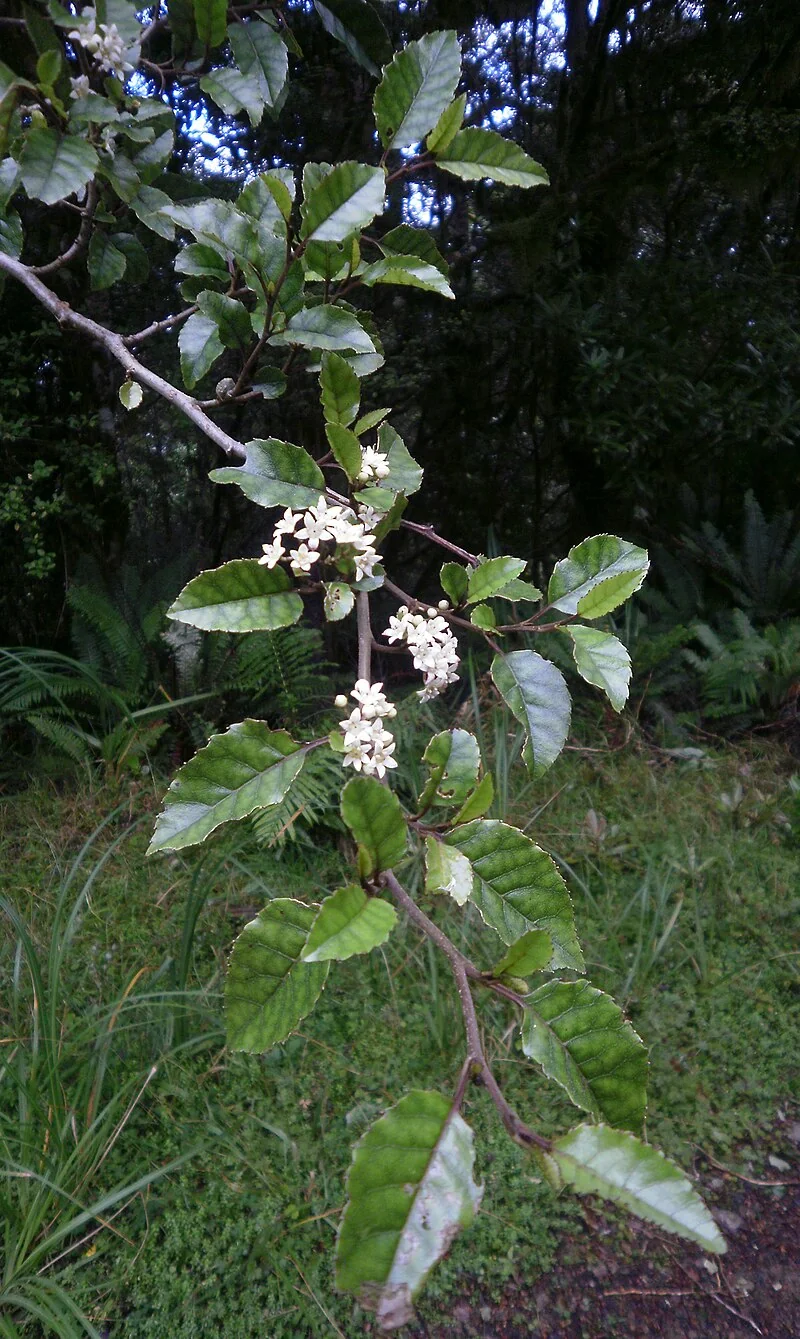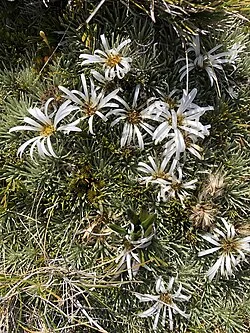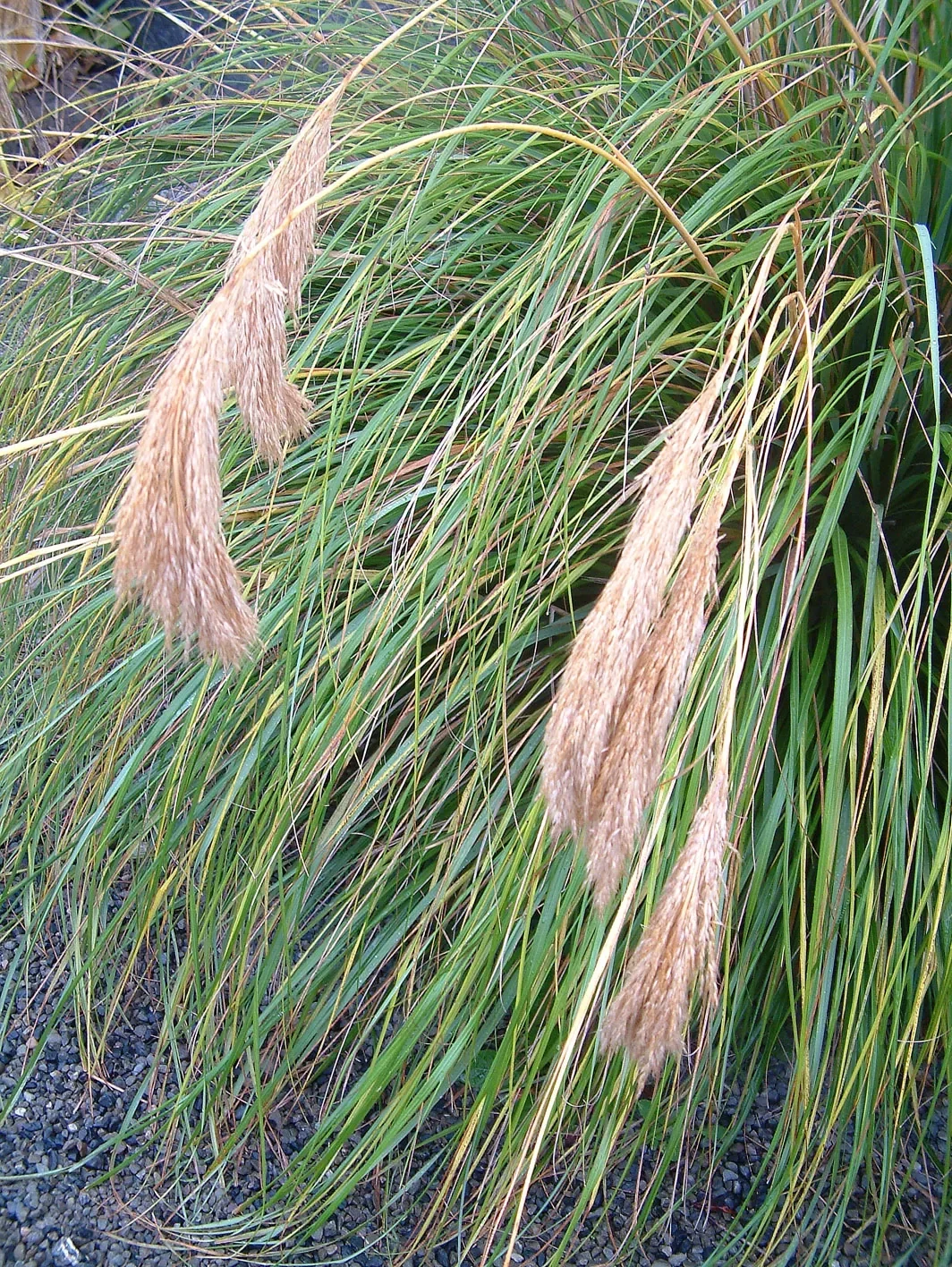
Kirk's Broom
Carmichaelia kirkii
Introduction
Overview
Kirk's Broom ( Carmichaelia kirkii ) is a rare native shrub distinguished by its scrambling, leafless stems and critically endangered conservation status. This unique species produces photosynthesis through its green, flattened branches rather than traditional leaves, creating an unusual and distinctive appearance. Endemic to specific locations in Canterbury and classified as Threatened - Nationally Vulnerable, Kirk's Broom represents one of New Zealand's most precious botanical treasures, requiring specialized care and conservation efforts to ensure its survival for future generations.

Kirk's Broom is a rare and unusual native shrub, notable for its semi-climbing, leafless branches that form a tangled vine-like shrub. It is endemic to the coastal and lowland areas of the South Island. In summer, it produces clusters of small, attractive pea-like flowers, which are typically white or lilac with purple veins. As a threatened species, growing Kirk's Broom in your garden can contribute to its conservation among New Zealand's native shrubs .
Quick Facts
| Scientific Name | Carmichaelia kirkii |
|---|---|
| Common Name | Kirk's Broom, Native Broom |
| Family | Fabaceae |
| Height | 2-4 m (as a scrambling shrub) |
| Spread | 1-2 m |
| Water Needs | Low to moderate, drought tolerant |
| Light | Full sun to partial shade |
| Frost Tolerance | Hardy |
| Salt Tolerance | Moderate; tolerates coastal conditions |
| Growth Rate | Moderate |
| Lifespan | Long |
Climate Best Suited to
White maire (Nestegis lanceolata) is primarily found in lowland to hilly forests across the North Island of New Zealand, extending to the Marlborough Sounds in the South Island. It demonstrates good adaptability to various conditions, thriving in areas with well-drained soils and tolerating both full sun and partial shade. Its natural distribution suggests a preference for warmer, more humid environments but with a reasonable tolerance for cooler temperatures found in its southern range.
Regional Suitability
| City | Climate Suitability |
|---|---|
| Whangārei | Ideal |
| Auckland | Ideal |
| Hamilton | Ideal |
| Tauranga | Ideal |
| Rotorua | Ideal |
| Gisborne | Ideal |
| New Plymouth | Ideal |
| Napier | Ideal |
| Whanganui | Ideal |
| Palmerston North | Ideal |
| Wellington | Ideal |
| Nelson | Ideal |
| Christchurch | Ideal |
| Dunedin | Moderate |
| Invercargill | Moderate |
Natural Habitat
Geographic Distribution
Understand the natural habitat of Kirk's Broom ( Carmichaelia kirkii ), including its geographical distribution, preferred environmental conditions, and the types of ecosystems where it once thrived. This knowledge is crucial for both conservation efforts and replicating natural conditions in cultivation.
- Historical and current geographical distribution in the South Island.
- Preferred coastal and lowland habitat conditions.
- Associated plant communities and ecosystem relationships.
Plant Conservation
Carmichaelia kirkii, also known as climbing broom or Kirk's broom, is classified as "Nationally Vulnerable" in New Zealand. This conservation status has been consistently reported in assessments from 2013, 2018, and 2023. Older reports from 2007 had previously listed it as "Nationally Endangered".
This species is endemic to the eastern and inland South Island of New Zealand, found in regions such as Marlborough, Canterbury, and Otago. It typically grows in grey scrub communities, often on toe slopes and gully sides. Threats to Carmichaelia kirkii include habitat modification and loss, stock browsing, fire, and inappropriate weed spraying.
Growing Requirements
Soil Requirements
White maire (Nestegis lanceolata) is remarkably adaptable to different soil conditions, thriving in well-drained environments. It can tolerate a variety of soil types, from sandy to loamy, and prefers a neutral to slightly acidic pH. Good drainage is crucial to prevent root rot, ensuring healthy growth and development.
- Tolerates a wide range of soil types from clay to sandy
- Prefers well-draining soils but can handle occasional waterlogging
- Thrives in moderately fertile soils but will grow in poor soils too
- Can tolerate slightly acidic to slightly alkaline pH
- Handles coastal conditions including salt spray
Light Requirements
White maire (Nestegis lanceolata) thrives in a variety of light conditions, from full sun to partial shade. Optimal growth and flowering are typically achieved in locations receiving ample sunlight throughout the day. However, it can also tolerate some shade, especially in hotter climates, where it benefits from protection during the most intense afternoon sun.
- Full sun for optimal growth and form
- Can tolerate partial shade but may develop a leggier form
- At least 6 hours of direct sunlight daily is ideal
- Northern or eastern exposures work well in garden settings
Water Requirements
Once established, White maire (Nestegis lanceolata) is remarkably drought-tolerant, requiring minimal supplemental watering. During its establishment phase, consistent moisture is crucial to encourage strong root development. Mature plants can withstand dry periods, but regular watering during prolonged droughts will promote healthier growth and more abundant flowering.
- Moderate watering during establishment (first 1-2 years)
- Drought-tolerant once established
- Can handle periods of soil saturation
- Reduce watering in winter when growth slows
- Signs of overwatering include yellowing leaves and crown rot
Planting Guide
-
Best Time to Plant
The best time to plant Kirk's Broom is in spring or autumn, when temperatures are mild and rainfall is more reliable. This allows the plant to establish its root system before the stress of summer heat or winter cold.
-
Choosing a Location
Select a sunny or partially shaded location with well-drained soil. This plant can be grown as a standalone shrub, trained as a climber against a wall or fence, or allowed to scramble naturally through other shrubs. Ensure good air circulation.
-
Planting Steps
Dig a hole twice the width of the pot and the same depth. Gently remove the plant from its container and place it in the hole, ensuring it sits at the same depth as it was in the pot. Backfill with soil and water thoroughly. Mulching is generally not recommended for this species.
Ecological Significance
Ecosystem Functions
As a nitrogen-fixing legume, Kirk's Broom ( Carmichaelia kirkii ) plays a crucial ecological role in enriching the soil and supporting coastal plant communities. Its flowers provide a vital food source for native insects, and its dense, tangled branches offer shelter for small birds and lizards.
- Nitrogen-fixing capability enriches coastal soils for other plants
- Flowers provide nectar for native bees, butterflies, and other pollinators
- Dense branching structure creates microhabitats for small native fauna
- Root system helps stabilize coastal and lowland soil structures
- Important component of threatened coastal plant communities
Uses and Significance
Garden Uses
- Specimen tree for visual impact
- Suitable for native gardens and restoration projects
- Enhances native garden aesthetics and biodiversity
- Provides architectural accent with its unique structure
- Effective for erosion control on slopes and banks
Ecological Value
Ecologically, White maire (Nestegis lanceolata) plays a crucial role in supporting native ecosystems. Its fruits are a food source for birds, especially the kereru, contributing to the local biodiversity and food web.
- Provides a vital food source for native birds, especially the kereru
- Offers habitat and nesting sites for various fauna
- Contributes to soil stabilization and nutrient cycling
- Forms natural shelter belts, protecting other species
Landscaping Applications
Design Integration
Discover how Kirk's Broom ( Carmichaelia kirkii ) can be effectively integrated into various landscaping designs. This section offers creative ideas and practical advice for using this unique threatened species to enhance conservation gardens and specialized plantings.
- Design ideas for conservation and wildlife gardens.
- Best uses in coastal and specialized native plant gardens.
- Combining with other threatened species for conservation impact.
Seasonal Care Calendar
Spring
In spring, White maire (Nestegis lanceolata) begins its active growth phase. New foliage emerges, and it's an ideal time for planting new specimens or propagating. Ensure adequate moisture and monitor for early signs of pests.
- New growth begins with fresh foliage development
- Apply a balanced, slow-release fertilizer if desired
- Excellent time for planting new specimens or dividing offsets
- Monitor for new pest activity and address promptly
Summer
Summer is the peak growing season for White maire (Nestegis lanceolata), often accompanied by flowering. Consistent watering is important, especially for young plants, to support vigorous growth and prevent stress during dry periods.
- Flowering typically occurs in early to mid-summer (November-January)
- Water young trees regularly during extended dry periods
- Avoid heavy pruning during the active growing season
Autumn
During autumn, White maire (Nestegis lanceolata) prepares for the cooler months. Fruits or berries develop, providing food for native birds. It's also a good time for planting and general garden cleanup.
- Fruits or berries develop and ripen (December-February), attracting birds
- Natural leaf shedding occurs as part of its growth cycle
- Good time for planting new specimens to establish before winter
- Clean up fallen leaves if a tidy appearance is desired
Winter
Winter is generally a dormant period for White maire (Nestegis lanceolata). Minimal care is required, though young plants may benefit from protection in colder regions. This is an opportune time for any necessary structural pruning.
- Generally dormant with minimal growth activity
- No special winter protection needed in most mild climates
- Suitable time for structural pruning if required
- Fallen leaves can be left as mulch or removed for tidiness
When to Prune and How Much
White maire (Nestegis lanceolata) generally requires minimal pruning to maintain its natural form and health. Pruning should focus on removing dead or damaged growth and shaping the plant as needed.
- Remove dead, damaged, or diseased branches at any time of year
- Light formative pruning when young helps establish good structure
- To create a multi-trunked specimen, cut the main stem to encourage branching
- Fallen leaves can be removed for a tidier appearance, or left as natural mulch
- If necessary, lower branches can be removed to create clearance underneath
- Major pruning is best done in late winter to early spring before new growth
Always use clean, sharp tools for pruning to minimize the risk of disease and ensure clean cuts. The plant often responds well to pruning with vigorous new growth, contributing to a fuller, healthier appearance.
How to Grow Kirk's Broom
From Seed
Kirk's Broom ( Carmichaelia kirkii ) is most reliably propagated from seed. Collect ripe pods in late summer to autumn and extract the small, hard seeds typical of New Zealand brooms (Fabaceae). To improve germination, scarify the seed coat by gently nicking it with a file, or by pouring hot (not Sow into a very free-draining seed-raising mix and cover lightly (about 2-3 mm). Maintain bright light and excellent airflow at 15-22°C, keeping the medium evenly moist but never waterlogged. Germination can begin within 2-6 weeks, though some seed may be slower. As soon as the seedlings are large enough to handle, prick them out into individual tubes to protect the developing taproot, using a gritty, low-fertility mix. Because Carmichaelia species form nitrogen-fixing symbioses, a native-friendly medium or a small amount of local soil can support early rhizobia nodulation and vigorous early growth. Harden plants off gradually and establish in full sun with very sharp drainage, mirroring the open, coastal and lowland habitats associated with this threatened species.
From Semi-Hardwood Cuttings
Cutting propagation is feasible but typically slower and less uniform than seed. Take firm semi-hardwood cuttings 6-10 cm long from healthy current-season shoots in late spring through summer. Remove lower side shoots, retain a small tuft at the tip, and make a clean basal cut just below a node. Treat the base with a rooting hormone (IBA 0.3-0.8%) and insert into a very free-draining medium such as 1:1 perlite and coarse sand. Provide gentle bottom heat (18-22°C) and maintain high humidity without prolonged leaf wetness; good ventilation and bright, indirect light are important for this largely leafless, cladode-bearing genus. Rooting may take 8-12+ weeks; pot on carefully into a gritty, fast-draining mix and harden off in high light. Establish outdoors only into full-sun, very
Pests and Diseases
Disease Resistance
This is a hardy plant that is generally resistant to pests and diseases. Good drainage is the most important factor in keeping the plant healthy, as it is susceptible to root rot in waterlogged soils.
Cultural Significance
Kirk's Broom (Carmichaelia kirkii) was used by Māori for various purposes. The tough, flexible stems were used for weaving and construction, and the plant also had medicinal uses in rongoā (traditional Māori medicine).
Bonus Tip
Unique Adaptations and Conservation
Carmichaelia kirkii is unique among New Zealand brooms as it is the only climbing species in its genus. In its natural habitat, it often scrambles through other shrubs for support. This unusual growth habit, combined with its leafless stems, makes it a fascinating and distinctive plant. Interestingly, it has shown some resistance to browsing by rabbits, which are a significant threat to many native plants in New Zealand.







